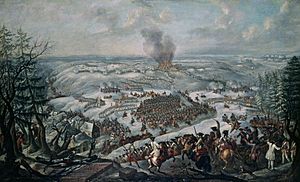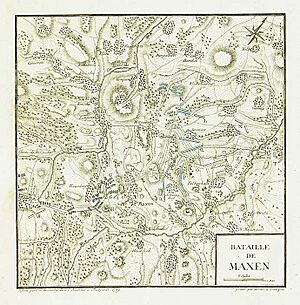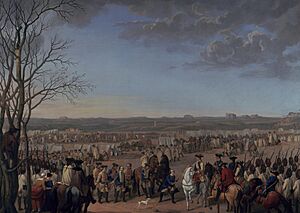Battle of Maxen facts for kids
Quick facts for kids Battle of Maxen |
|||||||
|---|---|---|---|---|---|---|---|
| Part of the Third Silesian War (Seven Years' War) | |||||||
 Painting by Franz Paul Findenigg, circa 1760 |
|||||||
|
|||||||
| Belligerents | |||||||
| Commanders and leaders | |||||||
| Leopold Josef Graf Daun | Friedrich August von Finck (POW) |
||||||
| Strength | |||||||
| 32,000 | 14,000 | ||||||
| Casualties and losses | |||||||
| 304 dead, 630 wounded | 2,000 dead and wounded, 11,741 captured | ||||||
The Battle of Maxen took place on November 20, 1759. It was fought near the town of Maxen in Saxony, a region in Germany. This battle was part of the Third Silesian War, which itself was a part of the larger Seven Years' War. The battle ended with the surrender of a large group of Prussian soldiers.
A Prussian army group, called a corps, had about 14,000 men. It was led by General Friedrich August von Finck. He was one of King Frederick the Great's generals. Finck's mission was to cut off the supply routes between the Austrian army and Bohemia. But on November 20, 1759, Austrian Field Marshal Leopold Josef Graf Daun attacked Finck's isolated corps. Daun's army was much larger, with 40,000 men. The Austrians defeated the Prussians. The next day, General Finck decided to surrender his entire force.
Why the Battle Happened
The year 1759 was tough for the Kingdom of Prussia. They had won many battles before, but now faced big problems. Prussia was fighting against many enemies. These included the Austrian Empire, the Holy Roman Empire, France, Russia, and Sweden.
King Frederick II of Prussia usually attacked first. But his army was tired and had lost many soldiers. So, he had to change his plan. He decided to play defense instead. His main goal was to stop the Austrian and Russian armies from joining forces. But this didn't work out well. On July 23, 1759, the Prussian army lost the Battle of Kay. This allowed Russian and Austrian forces to meet up in Silesia. On August 12, they badly defeated Frederick II at the Battle of Kunersdorf.
The defeat at Kunersdorf left the Prussian army in bad shape. It also left the way open to Berlin, Prussia's capital. But the allied armies didn't take advantage of this. The Russians had lost many soldiers too. They eventually went back to their camps in Poland. This left the Austrians alone, and they also pulled back from Silesia.
While this was happening, another Austrian army was fighting in Saxony. Saxony was a region that the Prussians had taken over. This Austrian army was led by Marshal Leopold Josef Graf Daun. They were fighting against Prussian forces led by Prince Henry of Prussia. The Austrians first gained ground. They even took Dresden, the capital of Saxony, on September 6. But on September 25, Prince Henry won a battle at Battle of Hoyerswerda. This victory threatened the Austrian supply lines to Bohemia. So, Daun had to order his troops to retreat south. However, he still held Dresden.
Frederick II returned to Saxony to help his brother, Prince Henry. They met up on November 13. Saxony was important for the Prussians. It provided supplies and new soldiers. Even though winter was coming, Frederick decided to keep fighting. He wanted to push Daun back to Bohemia and get Dresden back. To make the Austrians leave Dresden, Frederick made a risky move. On November 15, he sent General Finck's army group to go behind Daun's forces. Finck's job was to threaten the Austrian supply lines. But this move also left Finck's troops alone. They were surrounded by a much larger Austrian army. This invited Daun to attack them.
The Battle Begins
On November 19, General Finck's forces reached the village of Maxen. They had about 14,000 men. Maxen is in a small valley in the Ore Mountains. Meanwhile, Daun's Austrian forces had reached Dippoldiswalde. This town was southwest of Maxen. Other Austrian troops were further north. Some Imperial Army (Reichsarmee) units were guarding Dohna to the northeast. Daun had about 32,000 men. He set up camp for the night. Finck, on the other hand, took up defensive positions in the hills around Maxen.
On the morning of November 20, the Austrians began to move. Daun's troops left Dippoldiswalde in four groups. They headed towards Maxen. Other Austrian forces also moved south to join them. The ground was frozen and covered with a light layer of snow. This made it hard for the cavalry (soldiers on horseback) and artillery (cannons) to move.
The first Austrian soldiers met Prussian guards near Rheinhadrtsgrimma. The Prussians pulled back as Finck had ordered. Austrian grenadiers (special soldiers) then climbed the hills behind the town. This allowed their cannons to fire on the left side of the Prussian line. Around 11:00 AM, a heavy cannon battle began. It lasted for about 45 minutes. Then, Daun ordered his troops to advance. Five groups of Austrian grenadiers attacked the hills in front of Wittgensdorf and Maxen. They pushed back the Prussian soldiers holding these hills. The Austrians even entered Maxen itself. This cut off the entire left side of the Prussian army. They had to turn north towards Schmorsdorf village.
At the same time, another Austrian group was attacking the right side of the Prussians. They managed to get around the Prussian line. Finck tried to stop them. He sent a group of cuirassiers (cavalry with armor) to counterattack. But the ground was too difficult for the Prussian cavalry. Their attack was easily stopped by the Austrian foot soldiers.
Finck tried to gather his confused soldiers near Schmorsdorf. Daun's troops then joined up with the other Austrian forces. The Austrians launched a full attack. This caused the Prussian foot soldiers to break and run. They left many flags, cannons, and prisoners behind. The Prussian cavalry tried to fight back. But they were charged by Austrian dragoons (another type of cavalry) and also forced to retreat.
Finck led what was left of his army. He tried to join up with General Wunsch's soldiers. Wunsch's group was fighting the Imperial Army troops at Dohna. But the Prussians were now completely surrounded. The Austrians were firmly in control of the hills they had taken. They received supplies and fresh soldiers during the night.
Finck planned to try and break out of the encirclement the next day, November 21. He wanted to attack from Schmorsdorf. But his foot soldiers were almost completely wiped out. So, the Prussian commander decided to ask the Austrians for a surrender. Meanwhile, his cavalry, led by Wunsch, tried to escape the battlefield. They attempted to get through the Imperial troops' lines.
Daun accepted the Prussian surrender. But he insisted that it also include Wunsch's cavalry. Finck argued that Wunsch's group was separate. However, Finck learned that Wunsch had failed to find an escape route for his cavalry. So, Finck finally agreed to sign the surrender for his entire force.
What Happened Next
General Finck's entire Prussian force was lost in the battle. About 3,000 Prussians were killed or wounded. Another 11,000 were taken prisoner. The Austrians also captured 71 cannons, 96 flags, and 44 wagons of ammunition. The Austrians, on the other hand, had only 934 soldiers killed or wounded.
The defeat at Maxen was another big blow to the Prussian army. King Frederick was so angry that General Finck was put on trial by the military. After the war, Finck was sentenced to two years in prison. However, Marshal Daun did not try to attack further after his victory. He moved his army to their winter camps near Dresden. This marked the end of the fighting for 1759.



